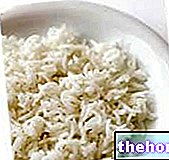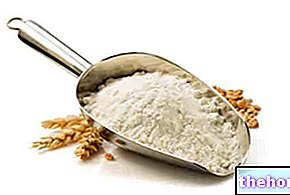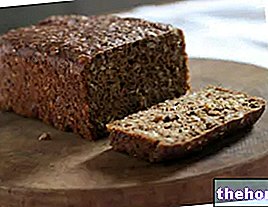Generality
Basmati it is a variety of long grain rice, typical of northern India and Pakistan.

- Typical flavor of "pandan" (Pandans amaryllifolius: herbaceous plant typical of these areas), thanks to the presence of the aromatic compound 2-acetyl-1-pyrroline;
- Low glycemic index, due to its chemical and nutritional characteristics.
Basmati Rice and Glycemic Index
According to Canadian Diabetes Association, cooked basmati rice boasts a glycemic index "medium", included in the range from 56 to 69.
The glycemic index
The glycemic index scale ranges from 0 to 100, where the latter represents the standard value referred to a dietary load of glucose. From 70 onwards, the glycemic index is considered high, while from 55 and below it is rated as low.
Compared to normal white cooked rice, which has a glycemic index of 89, basmati rice is more suitable for the diet of diabetics, but also of hypertriglyceridemics and the obese.
However, it is necessary to keep in mind that the glycemic index (speed of digestion from food and absorption of glucose) is a characteristic to be subordinated to glycemic load (i.e. the total amount of carbohydrates consumed with the serving).
In practice, the glycemic index plays a decisive role on the metabolic impact only "at the same" of glycemic load; it would therefore be useless to prefer (for example) a basmati rice over a common variety and then abound in portions.
THE INSULIN index
The glycemic index and the glycemic load are mainly reflected on the ability to stimulate insulin (anabolic hormone), which is why - in order to estimate the metabolic impact of food - a further (theoretically more significant) parameter has been defined, called insulin index.
This, which in a certain sense denotes the "fattening" potential of a food, with a constant glycemic load, is inversely proportional to the "glycemic index of the food; for this reason, basmati is considered the most suitable variety of rice for slimming diets and to nutritional therapy for overweight, type 2 diabetes mellitus, hypertriglyceridemia and metabolic syndrome.
Basmati Rice with Shrimps and Zucchini
Problems with playing the video? Reload the video from youtube.
- Go to the Video Page
- Go to the Video Recipes Section
- Watch the video on youtube
Background
The term "Basmati" derives from the word "vasmati", which in Sanskrit means "fragrant".
Basmati rice is hypothesized to have been initially cultivated in the Indian subcontinent for many centuries; the first written testimony can be traced back to the book Heer Ranjha, of 1766 AD. The food was then exported to the Middle East by Indian traders. This is why, today, Basmati rice represents not only a fundamental ingredient of Indo-Pakistani cuisine, but also of Persian, Arab and many other gastronomy in the surrounding area.
India and Pakistan are the sole producers and exporters of Basmati rice.
Production and Cultivation
The Indian basmati rice production areas are the states of: Madhya Pradesh, Punjab, Haryana, Rajasthan, Jammu & Kashmir, Himachal Pradesh, Delhi, Uttaranchal, Uttar Pradesh and Bihar. Total Indian production in 2011-2012, which ended in June, was 5 million tons. Haryana is the main place, where 60% of national production is exceeded.
In Pakistan, 95% of the cultivation of basmati rice takes place in the province of Punjab, where the total production of the year 2010 was 2.47 million tons.
Varieties and Hybrids
There are many varieties of Basmati rice.
Traditional Indian typologies include: Basmati 370, Basmati 385 and Basmati Ranbirsinghpura (RSPura). The Pakistani cultivars are: PK 385, 1121 Extra Long Grain Rice, super Kernel Basmati Rise and D-98.
Indian scientists of the "Agricultural Research Institute of Delhi, have produced a hybrid with “dwarf” seeds, which has improved various characteristics compared to the original one; among these: elongation of the seed, aroma and alkaline content. The product was called Pusa Basmati-1 (PB1, also known as Todal) and boasts a crop yield of up to 200% compared to the initial type.
From this species also aromatic rice derives, although they do not constitute separate varieties; these include PB2 (also called Sugandh-2), PB3 and RS-10.
The Indian types approved as basmati are: Dehradun, P3 Punjab, Uttar Pradesh type III, Safidon hbc -19, Haryana 386, Kasturi (Baran, Rajasthan), Basmati 198, Basmati 217, Basmati 370, Bihar, Kasturi, Mahi Suganda, Pusa (duplicate basmati) and 1121.
The Pakistani ones, on the other hand, are: Basmati 370 (Pakki Basmati), Super Basmati (Kachi Basmati), Basmati Cannabis, Basmati Pak (Kernal), Basmati 385, Basmati 515, Basmati 2000 and Basmati 198.
In the United States, there is a variety of rice derived from basmati called Texmati, while in Kenya there is another known as Pishori or Pisori (grown in the Mwea region).
Basmati Rice and Adulterations
The difficulty in differentiating the types of basmati "proper" from the others, and the significant price difference (greater in the basmati), led the fraudulent operators to adultery with crossed varieties and / or other long grain rice.
In Great Britain, in 2005, the Food Standards Agency found that about half of all marketed basmati rice was adulterated with other long-grain rice strains, prompting importers to sign a code of conduct.
In 2010, in the United Kingdom, tests on rice supplied by wholesalers revealed that 4 out of 15 samples contained cheaper rice mixed with basmati, while 1 even lacked the declared variety; the other 10 were in compliance with the law.
A PCR test based on genetic fingerprinting allows the identification of adulterated and healthy strains; the detection limit is 1% upwards and the error rate corresponds to ± 1.5%. Basmati rice exporters use this "genetic analysis to define a" certification of purity "to be attributed to their shipments of basmati rice. On the basis of this protocol, which was developed at the “Center for DNA Fingerprinting and Diagnostics”, the Indian company “Labindia” has made available detection kits to identify any sophistication of the load.
Battle of Patents on Basmati Rice
In September 1997, “RiceTec”, a Texan company, was granted the “American Patent” n. 5,663,484 for "basmati rice lines and grains". This patent protects the basmati lines, the similar ones and the relative analytical methods of the company.
RiceTec, owned by Prince Hans-Adam, a native of Liechtenstein, then faced international outrage and bio-piracy charges. The circumstance resulted in a (albeit brief) diplomatic crisis between India and the United States, with India threatening to bring the matter to the "World Trade Organization" (WTO) blaming the United States and RiceTec for the violation. commercial and intellectual property rights agreements (Agreement on Trade-Related Aspects of Intellectual Property Rights - TRID).
RiceTec subsequently withdrew most of the patent claims, including, most importantly, the right to call their rice lines "Basmati".
In 2001 the multinational was then granted a patent limited to the three varieties of rice developed by the company (non-basmati).
Other Cereals and Derivatives Amaranth Wheat starch Corn starch Rice starch Modified starch Oat starch Bulgur Whole grains Corn Flakes Crackers Oat bran Bran Cus cus Amaranth flour Oat flour Buratto flour Spelled flour Buckwheat flour Corn flour Corn flour Millet Barley flour Quinoa flour Small spelled flour (Enkir) Rice flour Rye flour Sorghum flour Flour and semolina Whole wheat flour Manitoba flour Pizza flour Spelled Rusks Focaccia Nuts Wheat or wheat Wheat germ Burnt wheat Buckwheat Breadsticks Oat milk Rice milk Corn Maizena Malt Millet Muesli Barley Stale bread Unleavened bread and Pita Bread Carasau bread Egg pasta Rice pasta Wholemeal pasta Piadina Small spelled Pizza Pop corn Baked goods Quinoa Rice Basmati rice Converted rice White rice Rice Wholemeal Parboiled Rice Puffed Rice Venus Rice Rye and Horned Rye Semolina Semolina Sorghum Spaghetti Spelled Teff Tigelle Triticale OTHER ARTICLES CEREALS AND DERIVATIVES Categories Food Alcoholics Meat Cereals and derivatives Sweeteners Sweets Offal Fruit Dried fruit Milk and derivatives Legumes Oils and fats Fish and fishery products Salami Spices Vegetables Health recipes Appetizers Bread, Pizza and Brioche First courses Second courses Vegetables and Salads Sweets and Desserts Ice creams and sorbets Syrups, liqueurs and grappas Basic Preparations ---- In the Kitchen with Leftovers Carnival Recipes Christmas Recipes Dietary Recipes Light Recipes Woman's Day, Mother's Day, Dad's Day Functional Recipes International Recipes Easter Recipes Recipes for Celiacs Recipes for Diabetics Holiday Recipes Valentine's Day Recipes Vegetarian Recipes Protein Recipes Regional Recipes Vegan Recipes




























